Congee is a savory rice porridge that I’ve wanted to make for quite some time. It’s a warm, comforting porridge made with rice, chicken, ginger, and sometimes other fun ingredients. Congee usually needs to simmer for quite some time, so the Instant Pot is a great way to make congee fast, but I’ve included stovetop directions for everyone else (it’s ridiculously simple either way). So, even though I’ve titled this “Instant Pot Congee”, don’t pass up this gem of a recipe just because you don’t own a trendy IP. It’s just toooooo good not to try.
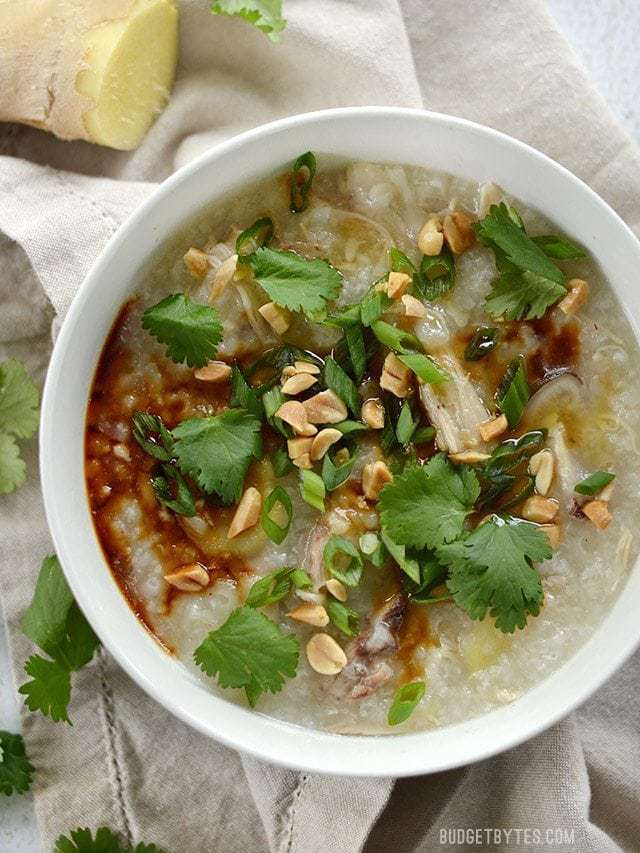
What is Congee?
Congee is a rice porridge that is a staple food in several countries in Asia. You’ll find many different versions and names for this dish, depending on the region, but they all have one thing in common–they’re warm, comforting, and filling. The base for congee is rice that has been cooked for an extended amount of time in water or both until it breaks down into a really thick porridge. It can be as simple as that, or it can have extra ingredients added, like meat and aromatics, to make it more of a full meal.
But that’s just a snapshot of the history and culture surrounding this classic comfort food. If you’d like to try an authentic congee recipe and learn more about congee, I highly suggest checking out these resources:
- Chicken Congee from Made with Lau
- The Secret to Making Chinese Congee from Tiff & Case (Youtube)
- How to Make Congee (Rice Porridge) from China Sichuan Food
- 20 Minute Congee from The Woks of Life
What Does Congee Taste Like?
Congee is a fairly mild dish, but the flavor is deep. Oh so deliciously deep. This version, made with chicken, has a mild chicken flavor, with a little extra umami kick from mushrooms, and a lovely ginger base note. I found the congee to be so velvety smooth and delicious that I could happily slurp it up on its own, but when I started adding fun toppings the meal was elevated to super-star status.
Add Toppings
I’d suggest using at least the base toppings that I have listed on the recipe card below:
- sesame oil
- soy sauce
- green onion
- cilantro
- chopped peanuts
Beyond that, the sky’s the limit. I gave the congee the “soft boiled egg and sriracha” treatment because I add those two things to just about everything, but the congee was really quite filling on its own, so I probably won’t opt for an egg in the future. The sriracha was a nice touch, though.
Here are a few other topping ideas:
- pickled vegetables
- fried onions or shallots
- sesame seeds
- steamed greens
But really, anything goes here. Sweep the kitchen!
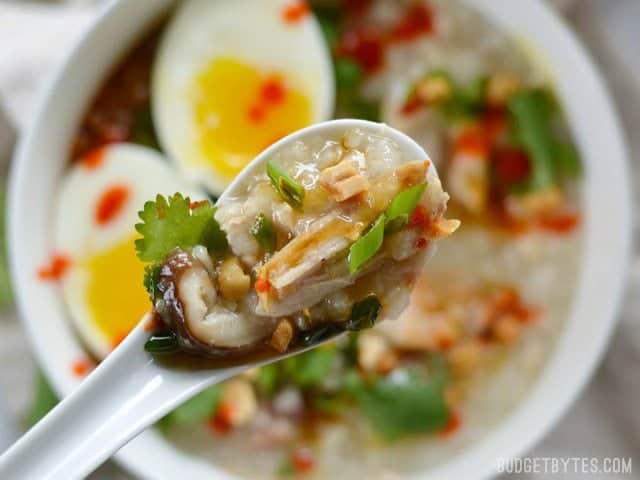
Instant Pot Congee (Rice Porridge)
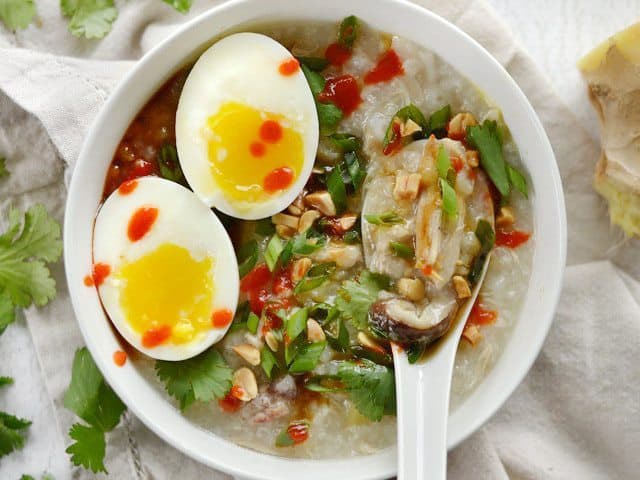
Ingredients
- 1 cup uncooked jasmine rice ($0.52)
- 2 cloves garlic ($0.16)
- 1-2 inches fresh ginger ($0.10)
- 3 shittake mushrooms ($0.63)
- 2 lb. bone-in chicken pieces ($3.66)
- 7 cups water ($0.00)
- 1/2 Tbsp salt (or to taste) ($0.05)
TOPPINGS
- 3 green onions, sliced ($0.23)
- 1/4 bunch cilantro (optional) ($0.20)
- 1/3 cup peanuts, chopped ($1.12)
- 1 Tbsp soy sauce ($0.05)
- 1 Tbsp toasted sesame oil ($0.33)
Instructions
- Peel and slice the ginger, and crush the cloves of garlic. Slice the mushrooms into thin strips. Remove the skin from the chicken pieces.
- Place the uncooked rice in the bottom of the Instant Pot and add the crushed garlic, sliced ginger, and sliced mushrooms on top. Lay the chicken pieces over the rice and aromatics. Finally, add seven cups of water.
- Close and lock the lid of the Instant Pot. Turn the steam release valve to the “sealing” position. Press the “porridge” button to begin cooking (no need to adjust the time or pressure). After ten seconds the pot will begin to heat and build pressure. Once it reaches the required temperature and pressure, the display will begin to count down 20 minutes.
- After 20 minutes, the pot will switch to the “keep warm” setting and begin to drop in pressure. Allow the pot to reduce in pressure naturally, without opening the steam release valve. When the float valve falls back to the down position, open the steam valve, and then open the lid.
- Using tongs, carefully remove the chicken pieces and place them on a clean cutting board. Use two forks to shred the meat and remove the bones. Return the shredded meat to the pot.
- Stir and taste the porridge, and add salt as needed (I added 1/2 Tbsp). Only add enough salt to amplify the flavors, but leave room for the addition of soy sauce as a topping.
- Ladle the congee into each bowl and drizzle a small amount (1 tsp) of toasted sesame oil and soy sauce on top of each bowl. Sprinkle the sliced green onions, cilantro leaves, and chopped peanuts over top, then serve.
See how we calculate recipe costs here.
Notes
Nutrition
Scroll down for the step by step photos!
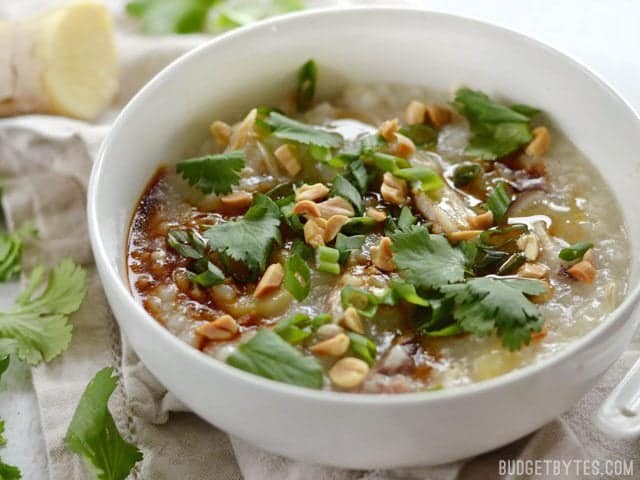
How to Make Congee in an Instant Pot – Step by Step Photos
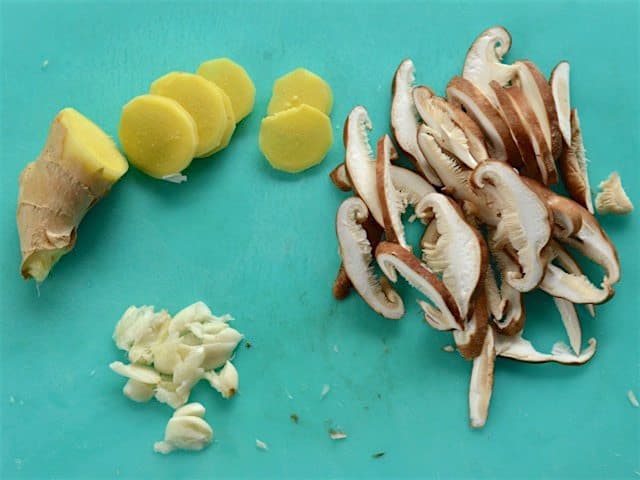
Start by peeling and slicing 1-2 inches of ginger (I really like ginger, so may use more next time). Thinly slice three shittake mushrooms and crush two cloves of garlic. Shittake mushrooms are pretty expensive ($8.99/lb. at my local stores), but since they’re mostly air and weigh next to nothing, I was able to get three fairly large mushrooms for $0.63. Not bad.
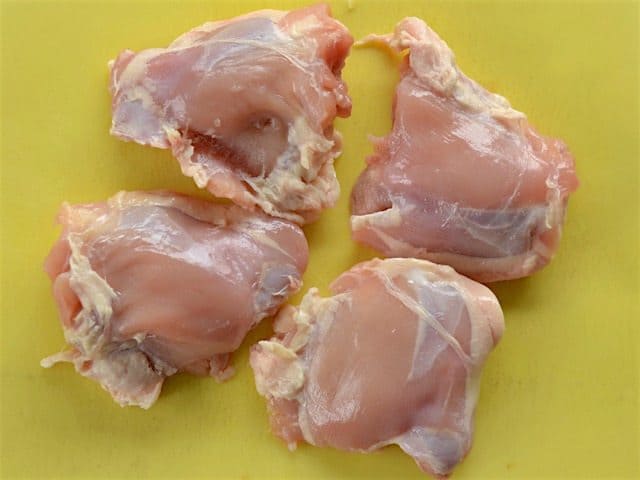
Remove the skin from about 2 lbs. of bone-in chicken pieces. Dark meat is going to give you a lot better flavor than breasts, so I highly suggest you stick to thighs and drumsticks. You can remove the excess fat as well, but I found that it made the porridge incredibly rich and velvety. Plus, trimming the fat is tedious. Ha.
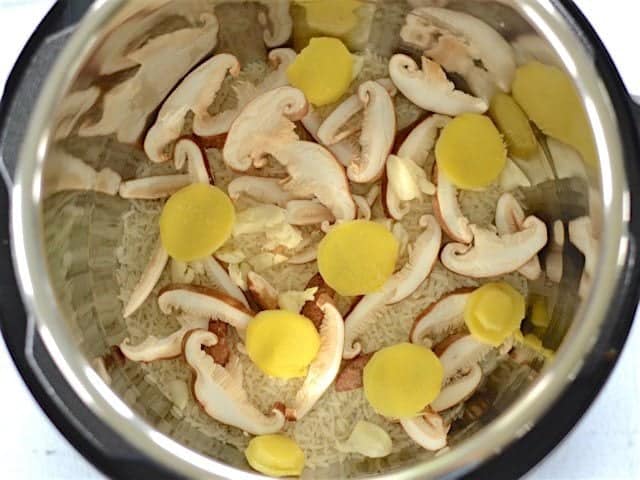
Place one cup uncooked jasmine rice in the bottom of the Instant Pot and add the ginger slices, crushed garlic, and sliced mushrooms on top.
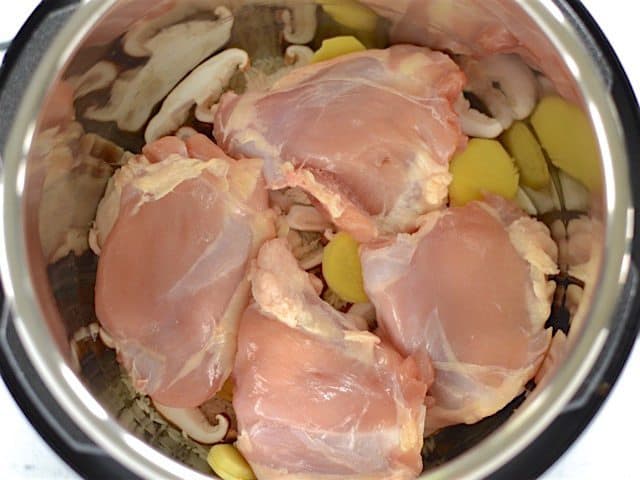
Then add the chicken pieces…
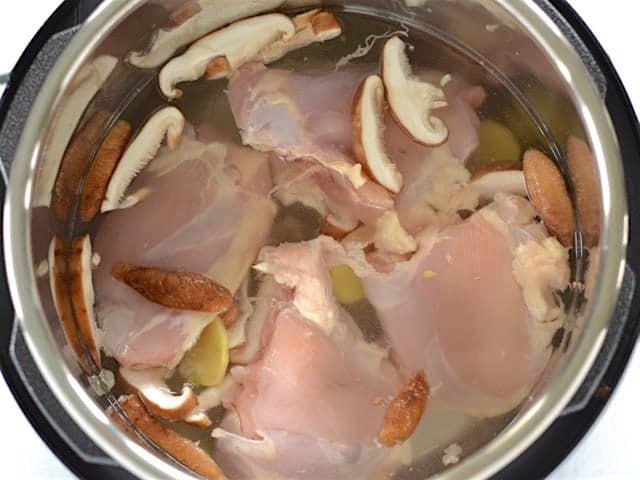
And finally, add 7 cups water.
If you’re making this on the stove top, just add all the ingredients listed above to a large pot, but use 10 cups water instead of 7 (you’ll get a lot more evaporation with the stove top method). Bring the pot to a boil (with lid) over high heat, then reduce to low and let simmer for 1-2 hours, stirring often, or until a thick porridge has formed. If the porridge is too thin after that time, simply let it simmer without a lid until it thickens.
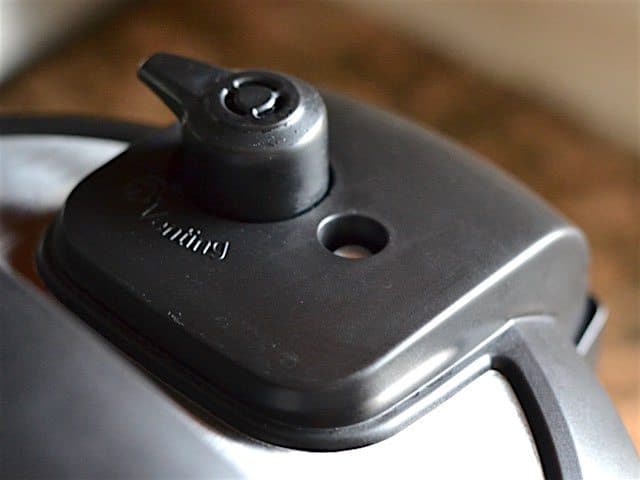
Close and lock the lid on the Instant Pot and turn the steam release valve (on the left in the photo) to the “sealing” position. Notice the float valve on the right, the small metal circle, is down. This means there is no pressure in the Instant Pot.
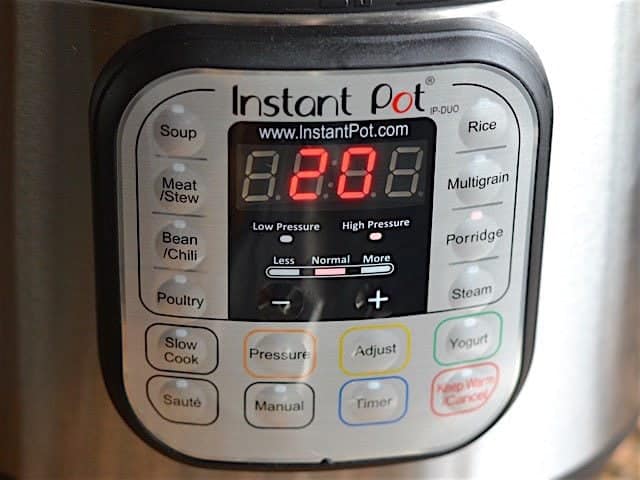
Press the “porridge” button over there on the right and it will turn on to the automatic setting of 20 minutes at high pressure. No need to adjust, just wait ten seconds for it to begin.
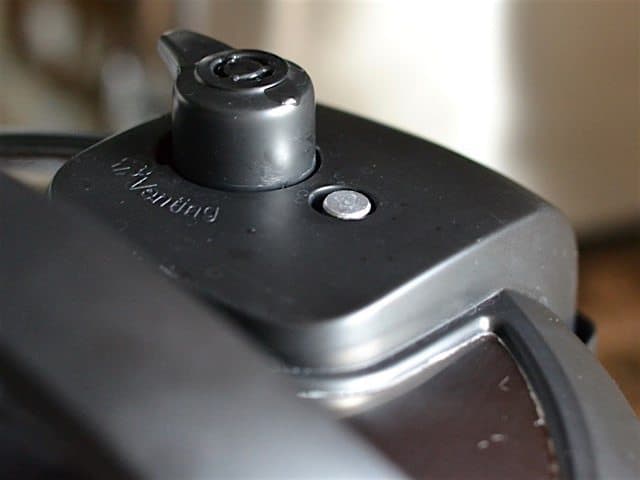
It may take 10-15 minutes for the pot to come up to temperature and pressure. Once it reaches high pressure, the float valve will be elevated (it’s that small metal circle on the right). That indicates that the pot is under pressure. Once it reaches the proper pressure, the display on the front will begin to count down 20 minutes.
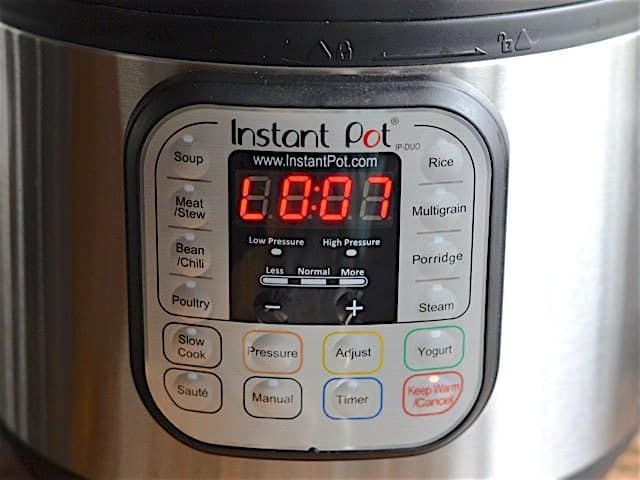
After cooking with high pressure for 20 minutes, the Instant Pot will beep and change to “keep warm” mode. The display will show an “L” and start counting up the time (it’s at seven minutes in the photo). Let the pressure naturally come back down, which may take 15 minutes or so. You’ll know the pressure is safe when that metal float valve has fallen back down.
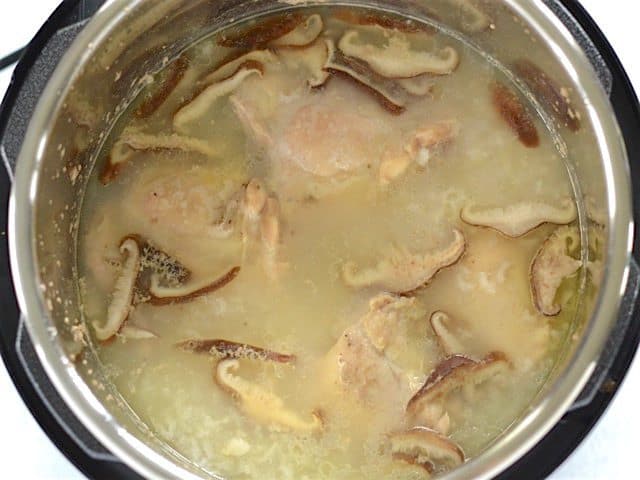
Once it’s back down to safe pressure, open the steam release valve, then open the lid. It will look a little something like this. It looks a little watery on top, but once it’s stirred it thickens right up. Carefully remove the chicken pieces with tongs and place them on a clean cutting board.
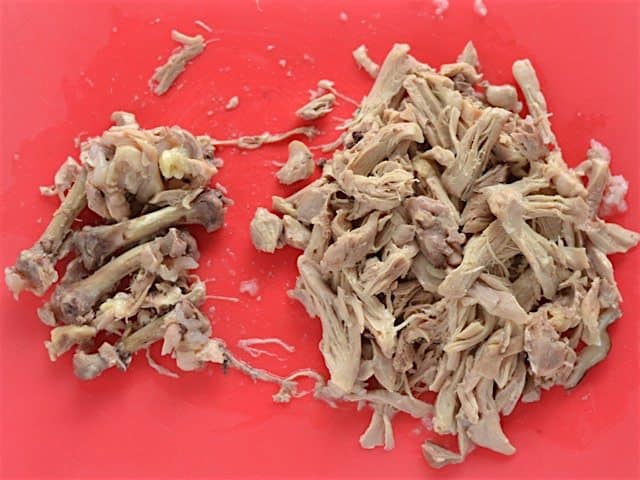
Use two forks to shred and pull the meat from the bones. The meat should be so tender that it literally falls apart when you touch it.
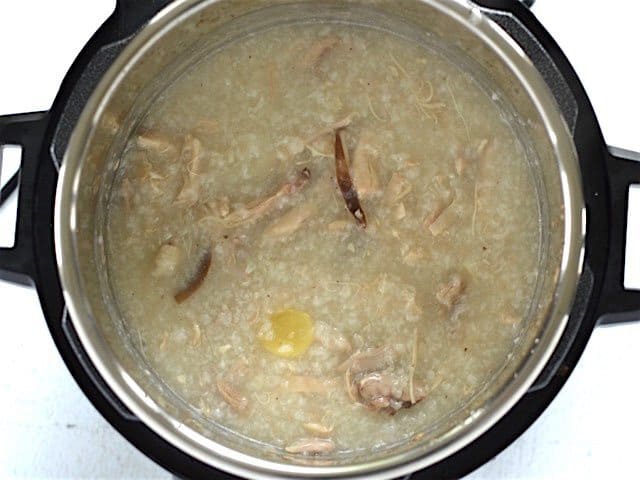
Stir the shredded meat back into the congee. Give it a taste and add salt to your liking (I added 1/2 Tbsp). You want enough salt to make the flavors pop, but not so much that you wouldn’t want to add soy sauce as a topping.
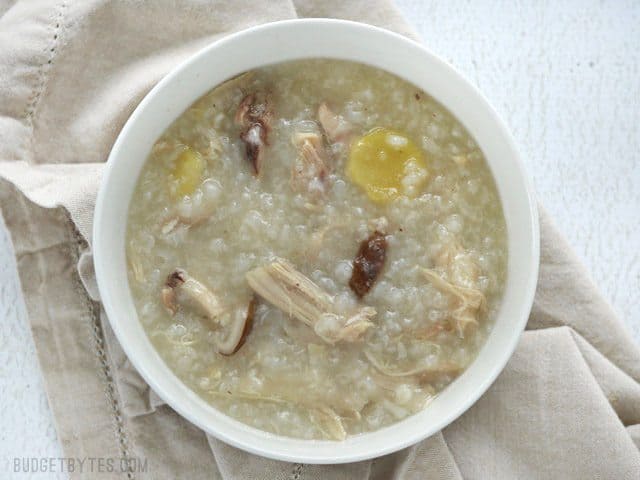
Ladle some congee into a bowl… I gotta say, too, that I love those ginger slices. They become quite mild through the cooking process and have a texture similar to water chestnuts. They’re SO GOOD. More ginger slices next time for sure.
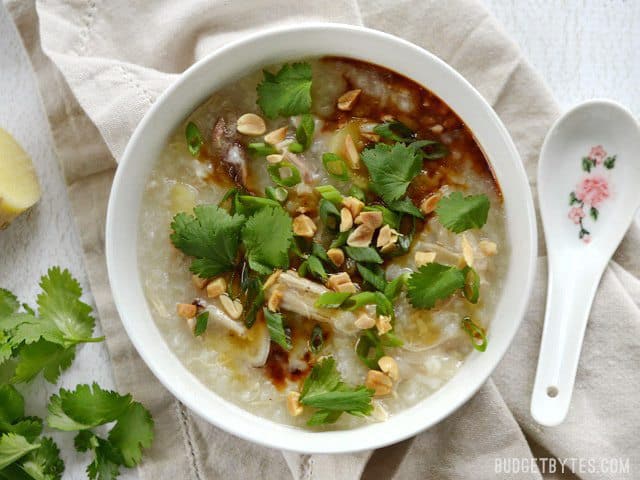
At a minimum, I’d suggest adding a small drizzle of toasted sesame oil & soy sauce to each bowl, along with some sliced green onions, cilantro leaves, and chopped peanuts to your Instant Pot Congee. The chopped peanuts were truly a delight. They added wonderful texture.
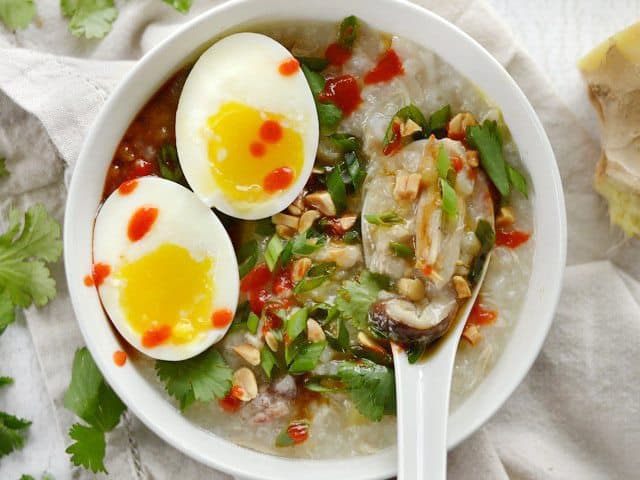
Or, you know, you could go crazy and add a soft boiled egg and some sriracha too… Cuz why not? Make your Instant Pot Congee your own!


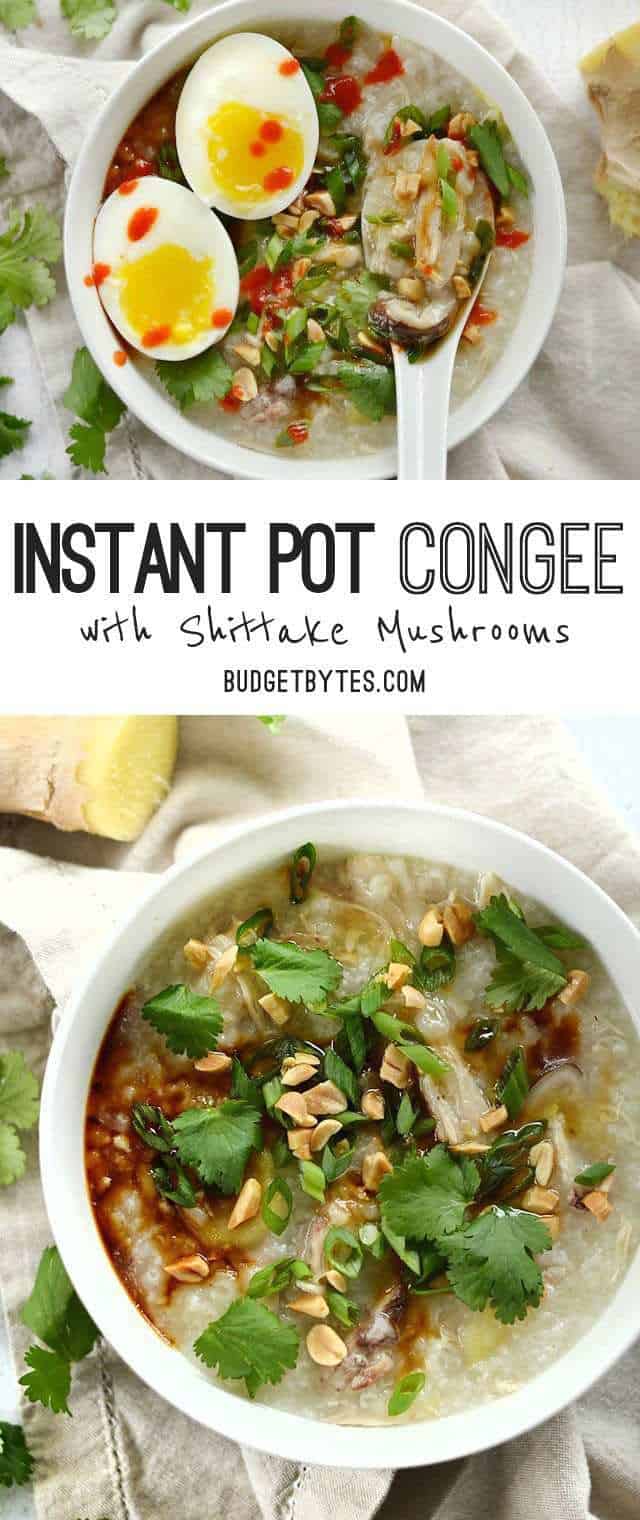
Oh wow! This was sooo good. I used the short grain rice that someone mentioned and added one sliced carrot. Pure comfort food. I love my Instant Pot
This looks like something that would work in a slow cooker. If I was going to try that, any idea how long to cook it for?
my guess the longer the better to make sure boned chicken is fully cooked
I’ve been making congee in my crock pot for years. I cook mine for 6 hours with chicken thighs, onion, and garlic. Then I get to add the yummy toppings. (I have some in my fridge as we speak.)
It does freeze well…if it lasts long enough at my house that is.
I would guess either 4 hours on high or 8 hours on low… but that’s just a guess. I bet you anything there are directions out there somewhere, though, because congee is such a popular recipe. :) Give google a shot with “slow cooker congee” to see if anyone has posted a recipe.
Thanks for replying. I’ll give it a try and see what I can find.
Hi Beth, the recipe looks great, do you know if it might freeze well?
I bet it would. Regular rice freezes really well, so I would assume this “thinner” rice would as well. If some water does separate out upon reheating, just stir it right back in. :)
jook (or congee) isn’t gibberish to those of us who have grown up with it. i would be careful not to alienate part of your audience and run the risk of losing followers.
I meant gibberish for the fact that people aren’t familiar with “instant pot” or “congee”. :)
This looks great! Any tips for storing it past the first day? Does it reheat well?
I just stored mine in the fridge and it reheats beautifully in the microwave. :)
Yay!!! Back in college, I spent a summer in Malaysia. I stayed at a Chinese college and there was a huge open area close to the school where 20-30 something food stalls were set up around a dining area. Congee was sold at a few of the stalls and was a popular breakfast item. I always think back to that summer and how awesome the food was (and totally unfindable here in America…at least in the areas I’ve lived! :(). So glad I’ll be able to at least recreate porridge now :)
I’ve wanted to make congee forever! Will definitely be trying this on the stove
This looks really great! My mom would make this for us all the time when we were sick. I love the toppings that used!
You should try it with a little bit of fish sauce as a topping. That’s what we use in our family and it gives it that extra kick of umami flavor.
Thanks for sharing!
How could I make a vegan version of this?
I’ve never made a vegetarian version, but a quick google search revealed that most people just use more mushrooms and a vegetable broth in place of the water. Here’s a great version from a friend/fellow blogger: http://www.macheesmo.com/vegetarian-congee/
How would you compare the texture to something like polenta? My family can be texture oriented, and several of my kids don’t care for polenta, grits, risotto, or other things with that creamy texture. They eat oatmeal fine, though!
Emily, the texture is basically oatmeal but instead of the oatmeal being made of oats, it’s made of rice.
– from a person whose Southeast Asian home country eats congee/jook for breakfast as one of many, many savory options and has grown up eating it her entire life.
It’s a little different than both, but I’d put it a little closer to grits or cream of wheat than oatmeal. It’s definitely smoother than oatmeal, and mine was a bit thinner as well (you can adjust the thickness by adding more or less water).
I love congee!!! My favorite topping is kimchi, you should try it.
I’ve only made jook in my IP a couple times so far. I like to add sliced up century egg to my jook at the end of the cooking process.
One thing you need to emphasize is why you need to let it do NPR (natural pressure release) versus QPR (quick pressure release). Jook is one of those things that will sputter out the valve if you try to do the QPR. Messy! :D
Ewww, good to know! I’ll add that. :)
You should also try this with Century eggs. They’re a bit of an acquired taste, but they add the strangest, yet most delicious depth to congee.
Congee is also a really good stomach settler if you’re ill. Leave out everything except the ginger slices
That looks really good. Have you considered using dried shiitakes? I can usually get a package for less than $2 at my local asian market, and they last forever in my pantry. I’d probably put them in whole, and then fish them out and slice them after cooking. Or you could pre-soak, slice, and then use the soaking water as part of your cooking liquid.
I’m definitely going to pick some up! Thanks for the tip. :)
JOOK is a Korean word that basically means thickened soup. Specifically we would call this Dak-Jook, as Dak means Chicken in Korean! Amazing dish that will bring back some fond memories for me. I shall give this a whirl. Of course, the way we do it is with the regular short-grain rice rather than the jasmine variety, and it does release more starch that creates the thick & delicious texture. I’m curious to see how it works with jasmine as you prescribed here.
I’m considering trying this out soon. It seems like a perfect meal for when you’re sick or it’s cold/rainy/snowy out.
Jeff – I have sushi rice (calrose) at home as well as standard white/brown long grain rice. Would the sushi rice give a more authentic texture?
I will also probably use dried shitakes (as mentioned by another commenter) since they are readily available and store somewhat indefinitely.
Kimchee topping sounds like a must as well.
I used calrose in mine and it worked great, making the rice very glutenous and thick. Since my husband is half-Chinese and is used to Chinese-style jook, we skipped cilantro, peanuts, and sriracha and went for the green onions, sesame oil, and soy sauce. I also stirred in some sambal olek. My husband said his mum used to make it with pork sometimes as well, and she always used dried shitake mushrooms with no problems. He said the only difference between fresh and dried is that the dried end up a fair bit chewier.